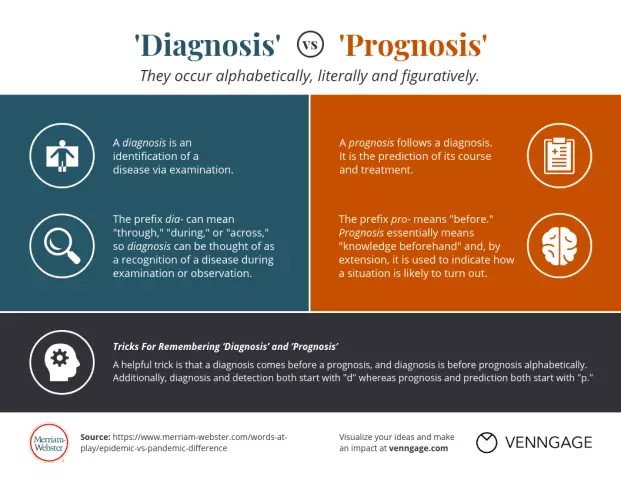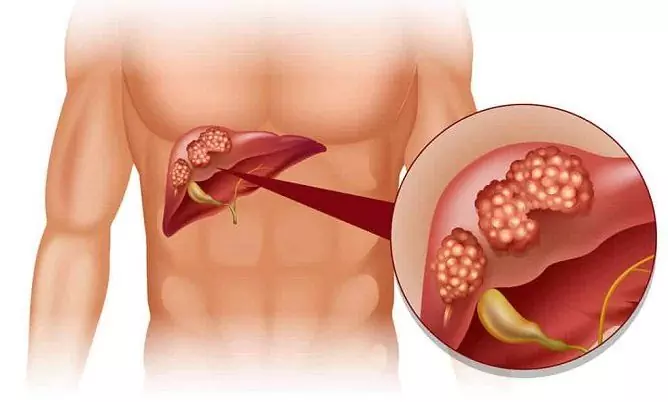- Author Rachel Wainwright [email protected].
- Public 2023-12-15 07:39.
- Last modified 2025-11-02 20:14.
Liver cancer

Liver cancer, annually this terrible diagnosis is made to approximately 250 thousand patients around the world. Primary liver cancer (in which a malignant tumor is localized in the liver) occurs 30 times less often than secondary (metastatic), in which only tumor processes appear in the liver.
It is noteworthy that primary liver cancer occurs most often in South Africa, Senegal, China and India, and men get it 4 times more often than women. The age range when the likelihood of developing liver cancer increases - 40 years.
What is liver cancer?
As mentioned above, there are two types of liver cancer: primary and secondary.
In the primary type, cancer cells are formed in the liver in the form of single or multiple formations of dense etiology, whitish color, without clear outlines. This type of tumor quickly grows into the vessels of the organ and spreads throughout the liver, forming metastases. Liver cancer often develops with chronic viral hepatitis B, against the background of liver cirrhosis, and is very difficult to treat. In secondary liver cancer, tumor metastases penetrate into the liver from other organs, where the malignant neoplasm is localized. Depending on the stage of liver cancer, in the secondary form, treatment can give a good result and prolong the patient's life up to 4-5 years.
Depending on the type of cells that are affected by cancer, there are epithelial, non-epithelial and mixed types of cancer.
Cholangiocellular cancer arises from epithelial tissues, affecting the bile ducts, hepatocellular - affecting liver cells, hepato-cholangiocellular - mixed type and undifferentiated type of liver cancer.
Hemangioendothelioma is formed from non-epithelial tissues, and carcinosarcomas and hepatoblastomas are referred to the mixed type of malignant liver cancer tumors.
Causes of liver cancer
Unfortunately, to date, scientists cannot accurately identify the causes of malignant tumors and determine the likely predisposition to cancer of any etiology. With a certain degree of certainty, we can talk about a hereditary predisposition, and the likelihood of liver cancer increases under certain circumstances. Such circumstances include a high level of environmental pollution, an unhealthy lifestyle, the quality and nature of nutrition, the presence of chronic liver diseases.
Studies show that excess iron in the body, cholelithiasis, hepatitis B, syphilis, liver parasites, and alcoholism contribute to the development of liver cancer.
Work in hazardous industries can have a high carcinogenic effect on the liver. Chemical products such as polychlorinated biphenyls, organic chlorine-containing pesticides, chlorinated hydrocarbon solvents, emit harmful substances that, when ingested, cause the growth of cancer cells.
And even the consumption of unnatural food, vegetables and fruits, for the cultivation of which pesticides and growth stimulants were used, significantly increases the risk of developing malignant tumors. Certain organic compounds found in foods, such as peanuts, can also cause cancer.
Liver cancer symptoms
Liver cancer, like any malignant formation in the human body, causes general weakness, hypodynamia, decreased appetite, anemia, nausea and vomiting and, as a result, weight loss. A patient with liver cancer begins to "feel" the affected organ, in the case of the liver, it is heaviness and pain in the right hypochondrium, an increase in the size and relief of the organ's surface. It should be noted that these manifestations directly depend on the stage of liver cancer, but given that the primary cancer develops and progresses rapidly, then already 2-3 weeks after the onset of the disease, palpation clearly felt changes in the size and surface of the liver, in some cases, even you can feel the tumor node.
With the development of cancer against the background of cirrhosis of the liver, and this happens in 60-90% of cases, the patient's pain sharply increases, jaundice increases, body temperature rises, nosebleeds and vascular mesh on the skin occur. Also, from the symptoms of liver cancer, one can distinguish the expansion of the subcutaneous veins of the abdominal wall, gastrointestinal bleeding, obstructive jaundice, ascites.
With a secondary type of liver cancer, metastases can be found in the liver itself, the lymph nodes of the liver gates, as well as in other organs of the body (lungs, kidneys, pancreas, etc.).
Diagnosis of liver cancer

At the initial stage, it is quite difficult to diagnose liver cancer due to the absence of specific symptoms. And since the disease progresses rapidly, the patient turns to doctors when there are already severe pains in the right hypochondrium, fever, weakness, abdominal deformity due to a greatly enlarged organ and other symptoms of liver cancer.
The initial diagnosis of liver cancer is organ palpation, then ultrasound examination (ultrasound), laboratory tests for bilirubin in the blood and urobilin in urine are shown. In cases of controversy, magnetic resonance imaging of the liver (MRI) and / or computed tomography (CT) is performed. But one of the most reliable studies is a liver puncture, which allows you to obtain accurate data on the morphology of the disease and to distinguish liver cancer from similar diseases.
Patients at risk, to detect the initial stage of liver cancer, can be tested for the content of fetoproteins in the blood. With an increase in these substances, in 70-90% of cases, one can judge the presence of a malignant tumor.
Liver cancer treatment
Unfortunately, this particular type of cancer is very difficult to treat, due to the importance of the liver as an organ in the life of the human body. Surgical removal of the tumor is possible only at an early stage, and subject to the formation of isolated small nodes. It is possible to establish the possibility of removing the tumor only during the opening of the abdominal cavity (laparotomy), but, as a rule, in most cases such patients are considered incurable and they are given only symptomatic treatment to alleviate the condition.
Intravenous chemotherapy in the treatment of liver cancer also does not give the desired effect, only the introduction of drugs into the hepatic artery can achieve some positive results.
With liver metastases, the treatment of liver cancer depends on the location of the nodes. The operation is performed only if one lobe of the liver is affected and there are no signs of metastases in other organs.
Liver cancer prognosis
As mentioned above, liver cancer progresses very quickly, thereby reducing the chances of successful treatment. Patients with such a diagnosis often belong to the incurable group. Literally 3-4 months after the onset of the disease, the patient may die. Given operable liver cancer, the prognosis is that life expectancy is 3-5 years after successful tumor removal.
Prevention of the disease
As it turned out, the development of liver cancer is highly promoted by chronic viral hepatitis B, parasitic liver diseases, the effects on the body of the poisons of the chemical industry, lifestyle and bad habits, namely alcoholism. Therefore, prevention of liver cancer is about taking care of your health, about the environment, and maintaining a healthy lifestyle. And also in case of the slightest "malfunction" in the body, the appearance of any frightening symptoms, it is imperative to consult a doctor, because a disease detected in time is much easier to treat and gives a chance for recovery.
YouTube video related to the article:
The information is generalized and provided for informational purposes only. At the first sign of illness, see your doctor. Self-medication is hazardous to health!






